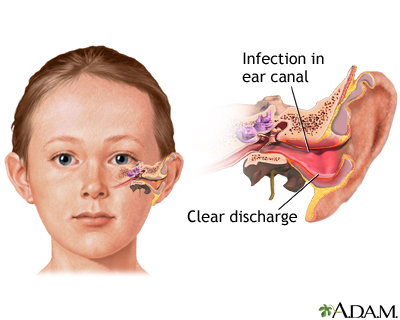Swimmer's ear is a type of ear infection where fluid collects in the ear canal due to pressure
The main symptom associated with swimmer's ear is that the fluid will turn red or dark red when touched. In more severe cases the fluid can turn purple.
Ear infections tend to start in one ear but there are times that they occur both in the ears simultaneously. The most common site for swimmer's ear is the inner side of the ear, on the inner edge of the ear drum. However, it can also be found in the middle ear canal. This type of infection can also spread to other parts of the head. It is very difficult to treat because it is caused by a build up of fluid.
Treatment involves cleaning the infected ear, using antibiotics to kill any bacteria present, and draining any excess earwax. There are some cases where the condition does not respond well to any of these treatments. In these cases surgery may be needed.
In most cases the fluid in the inner ear is removed using a syringe and some antibiotics. This is done before the pus in the ear develops any lumps.
If you have a bacterial ear infection, you may not need to do anything at all. Bacterial infection is very rarely related to swimming, so swimming is not likely to cause it. If you swim frequently then the chances of developing a bacterial ear infection are increased significantly.
People who swim often are more likely to develop more severe infections. Those who swim more than twice a week or who swim in chlorinated pools are more at risk.

The infection is not harmful but can be very uncomfortable
It can cause difficulty hearing and make it hard to carry out normal activities. As long as you take action as soon as possible and ensure you have a specialist in your ear examined and treated, the infection should clear up within a few days.
Swimmer's ear is very common and is usually easily treated using antibiotics. The fluid can drain down into the ear and so it can be treated just as easily. If it does not clear up on its own then you may need to use a specialist hearing aid.
The outer part of the ear canal is one of the most common sites of infection. It is usually caused by bacteria that has moved down through the ear into the surrounding area.
If there is an infection in the ear then the doctor will normally remove the earwax by gently scraping it out with a cotton bud. This will drain the excess fluid from the ear and stop the bacteria from spreading.
Bacteria which cause the infection can be eliminated by using a course of antibiotics. They work by killing off the bacteria. However, the ear wax can block the antibiotics from doing their job.
You may also need to take some form of antibiotic for this purpose. They can be bought over the counter, however, it is important to note that natural bacteria can also be an important source of infection. Antibiotics can work effectively against natural bacteria, and therefore a course of antibiotics may need to be taken longer to get rid of the infection.
It is extremely important that swimmers ear is kept clean and dry. Avoid swimming if you think you are suffering from this condition. If you feel you may be swimming in contaminated water then go for advice straight away. Your swimming canals should be thoroughly washed.